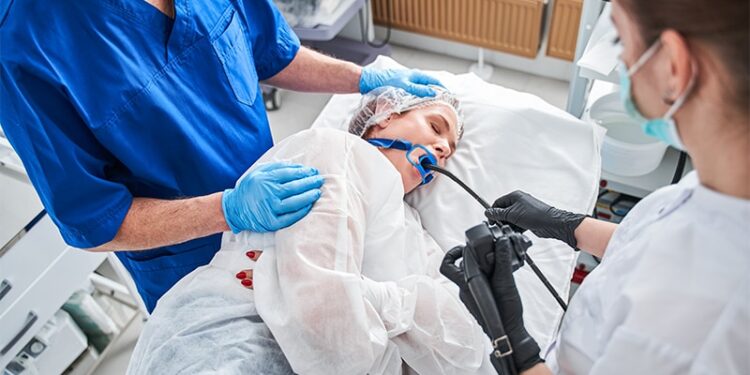Low rates of retained gastric contents were seen in endoscopy patients on GLP-1 receptor agonists ( RAs), a retrospective multicenter cross-sectional analysis reported in The American Journal of Gastroenterology. Moreover, most instances occurred in patients using the drugs for type 2 diabetes (T2D) rather than for weight loss alone.
The findings suggest adopting an individualized approach rather than universal preoperative withholding of GLP-1 RAs before endoscopy, concluded Jennifer Phan, MD, medical director of the Hoag Advanced Endoscopy Center in Newport Beach, California, and colleagues. These agents are associated with slowed gastric emptying, possibly raising the risk for pulmonary aspiration. The study identified comorbid uncontrolled T2D as a risk factor for retained gastric contents.
Recommendations from gastroenterological societies and the American Society of Anesthesiologists (ASA) differ regarding pre-endoscopic holding of these ubiquitous agents used for obesity and T2D. “Many patients undergo routine endoscopic procedures, and there was concern from the anesthesia safety perspective for retained gastric contents,” Phan told Medscape Medical News. “At first these events were seen in a handful of cases; however, out of precaution this resulted in a statement from the ASA recommending that patients hold their GLP-1 medications for at least 1 week prior to a routine endoscopic procedure.”
That guidance resulted in protocol changes within endoscopy units, cancelled procedures, and potential delays in patient care. “We wanted to study whether this concern was clinically valid and to help identify which subgroup of patients are at highest risk in order to best inform anesthesia and endoscopy practices,” Phan added.
The ASA updated its guidance in 2023.
The current study aligns with other research showing that rates of clinically relevant retained gastric contents are < 10%, Phan said. For instance, the American Gastroenterological Association (AGA) published a rapid clinical practice update in November 2023 that found insufficient evidence to support patients stopping the medications before endoscopic procedures. AGA guidance suggests an individual approach for each patient on a GLP-1 RA rather than a blanket statement on how to manage all patients taking the medications.
“Our initial hypothesis was that the rates of clinically relevant retained gastric contents in patients on GLP-1 RA medications would be low. This was born out of anecdotal experience of the limited number of aborted procedures we experienced before the ASA statement.”
Her group also hypothesized that the indication for which the GLP-1 RA was prescribed would be important, with patients taking GLP-1 RA medications for diabetes potentially having a higher likelihood of retained contents given the concomitant propensity for delayed gastric motility related to uncontrolled hyperglycemia.
The Study
The investigators identified 815 patients on confirmed GLP-1 RA medications of various types receiving endoscopy from 2021 to 2023 at four centers. Demographics, prescribing practices, and procedure outcomes were captured. GLP-1 RA management of preoperative holding was retroactively classified per ASA guidance.
Of the 815 patients (mean age, 67.7 years; 57.7% women; 53.9% White individuals), 70 (8.7%) exhibited retained gastric contents on endoscopy. Of these 65 (93%) had T2D with a median A1c of 6.5%. Among those with retained contents, most had a minimal (10, 14.3%) or moderate (31, 44.3%) amount of food retained, although 29 (41.4%) had a large quantity. Only one patient required unplanned intubation because of a large quantity of residual content, and none had aspiration events.
In multivariate analysis, the odds ratio of retention in those with diabetes was 4.1. “Given the predominance of diabetes in those with retained gastric contents, we highlight the potential to risk-stratify patients who require further preprocedural consideration,” the authors wrote.
Those with GLP-1 RA held per ASA guidance (406, 49.8%) were less likely to have retained contents (4.4% vs 12.7%; P < .001), but no significant differences for intubation (0% vs 2%; P = .53) or aborting procedure rates (28% vs 18%; P = .40) due to gastric retention were observed.
On multivariable analysis, the likelihood of food retention increased by 36% (95% CI, 1.15-1.60) for every 1% increase in glycosylated hemoglobin after adjusting for GLP-1 RA type and preoperative medication hold.
“Our study can help to differentiate which patients can be at largest risk for retained gastric contents,” Phan said, noting the impact of increasing percentages of A1C. “There’s a 36% increased likelihood of food retention in patients on GLP-1 medications, so a blanket policy to hold GLP-1s in patients who are nondiabetic and taking the medication for obesity may not be the best approach. But if patients have uncontrolled hyperglycemia, then an approach of caution is clinically valid.” In that context, holding the GLP-1 RA injection or lengthening the preoperative clear-liquid diet policy should be considered.
She noted that the study results are generalizable because the study was conducted across multiple types of hospital systems, both university and county, and included all types of GLP-1 RA.
Offering an anesthesiologist’s perspective on the study, Paul Potnuru, MD, an assistant professor in the Department of Anesthesiology, Critical Care, and Pain Medicine at UTHealth Houston and not involved in the study, called the findings “somewhat reassuring” but said the risk for aspiration was still a consideration.
A recent review, however, reported that the risk for GLP-1 RA-associated pulmonary aspiration was low.
Potnuru acknowledged that the original ASA guidance on preoperative GLP-1 RA cessation led to some confusion. “There were not a lot of data on the issue, but some studies found that even with stopping GLP-1s 2 weeks preoperatively some patients still retained gastric content,” he told Medscape Medical News.
A study at his center recently reported that 56% of GLP-1 RA users had increased pre-anesthesia residual gastric content compared with 19% of nonusers.
From the anesthesiologist’s clinical vantage point, the margin of safety is an issue even if aspiration risk is low. “If there’s a 1 in 1000 chance or even a 1 in 3000 chance, that can be considered too high,” Potnuru said.
He further noted that the current study included only 815 patients, not nearly enough for definitive data. In addition, a retrospective study based on medical records can’t really capture all the real-world procedural changes made in the operating room. “It’s common for anesthesiologists not to document all cases of intubation, for example,” he said.
While the ideal is a completely empty stomach, he agreed that a practical alternative to stopping GLP-1 RA therapy, especially that prescribed for diabetes, would be a 24-hour liquid diet, which would clear the stomach quickly. “If you stop these drugs in patients taking them for diabetes, you get a worsening of their glycemic control,” he said.
He noted that patients have different risk tolerances, with some willing to go ahead even if ultrasound shows gastric retention, while some opt to cancel.
Prospective studies are needed, Potnuru added, “because you find more if you know what you’re looking for.” His center is starting a clinical trial in 150 patients to assess the impact of a 24-hour, liquids-only diet on gastric retention.
According to Phan, other research is following GLP-1 RA users undergoing colonoscopy. “Future studies can look at the added value of point-of-care abdominal ultrasound to see if it increases precision preoperative management in these patients on GLP-1 medications.”
Other groups are examining the safety of these agents in the general context of sedation. “It’s worth noting that the studies are being done on currently available medications and may not apply to future medications such as triple agonists or anti-amylins that may come on the market in the near future,” Phan said.
This study received no financial support.
Neither the study authors nor Potnuru had any conflicts of interest.
Source link : https://www.medscape.com/viewarticle/more-evidence-supports-individualized-approach-pre-endoscopy-2025a1000je0?src=rss
Author :
Publish date : 2025-07-22 11:54:00
Copyright for syndicated content belongs to the linked Source.










